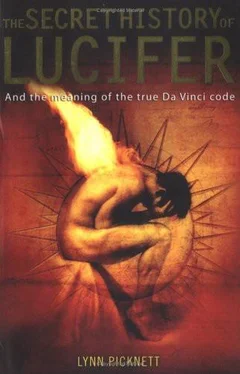Exorcism was necessary for, as we have seen, demons were genuinely believed to be everywhere, in the food the good Christians ate and the wine they drank, in the sidelong glance of a young woman at the well, even in the uncovered tresses of a nubile girl. To the early Christian, everyday life was beleaguered by Satan, a paranoia that in a sense was justified, for who knew which kindly seeming person was actually a spy, about to deliver them up to their pagan persecutors?
Of course all pagans were deemed to be inherently heretics, followers of the Devil, although, according to the Church Father Irenaeus, a heretic was any individual whom a bishop had singled out as a heretic. As Jeffrey Burton Russell remarks dryly, `Since no objective definition of "heretic" is possible, this definition was almost inevitable.'67
The pagans were clearly satanic, for their gods had even dared mimic Christ's life and death. The Egyptian Osiris, the Persian Tammuz and the Roman Mithras - not to mention several other dying-and-rising gods, such as the Greek Orpheus and Dionysus - were born at the winter solstice around 25 December in humble surroundings such as caves, their nativity attended by new stars, shepherds and Magi. They all died (on a Friday) in spring, to be resurrected miraculously a few days later. Incredibly, even today, some Christians explain away this awkward fact as a sort of diabolical parody on the part of the pagan myth-makers, even though this stretches blind faith rather thinly as most of these stories predated the life of Jesus by hundreds, perhaps thousands, of years. Sometimes it is suggested that at best these stories were invented as a rehearsal, a sort of feeble dry run for the real 'thing68
Even membership of the Church was no guarantee of a pristine soul. Bishop Ignatius declared that anyone who acted without the approval of his bishop was a Devil worshipper, although he admitted to being tempted himself by Satan to shirk his `duty' of martyrdom - an interesting theological and moral point. Here we have the Devil tempting him to save his life and the good God requiring him to commit a form of suicide, although of course that is a modern view, for which, no doubt, some wretched demon would have been blamed, had it been voiced in those far-off days. Ignatius wrote `I long to suffer, but I do not know whether I am worthy ... I need the meekness in which the prince of this world [Satan] is undone' 69 As Jeffrey Burton Russell notes: `Torture and death were [Satan's] work, and even kindness on the part of the pagans was a diabolical snare, since it might weaken the martyr's resolve' .70
Distasteful though this holy masochism may seem to most modern eyes - although Catholics are still encouraged to `offer up their suffering to God', who surely must be hoping for someone to offer up their joy and pleasure by now - it must be remembered that these zealots firmly believed that Christ was about to return at any moment and claim his own. (In fact, it is highly unlikely that Jesus ever intended to found a church for posterity, being apparently firmly of the belief that the end of the world was imminent. Certainly his disciples expected him to return in glory, signalling the end, at any moment. Ironically, Saint Peter's founding of the Church of Rome can be seen as the direct result of Christ's failure to return as promised in the Apostle's lifetime.) In the meantime a martyr's death would guarantee the early Christians eternal bliss.
Perhaps it was one way of glorifying, even simply of coping with, the persecutions that took the willing and unwilling alike and had them disembowelled by wild animals in the Colosseum or used as human torches. The arena became a potent metaphor for the battlefield between good and evil - indeed, an early Latin sermon depicts Satan as a gladiator attempting to ensnare the good Christians in his net," a perhaps unfortunate analogy, reinforcing the image of the enemy's virility at their own expense. (And ironically, this early Christian insistence on those who cause pain and humiliation being evil - and who can doubt it? - sits uncomfortably with later Inquisitorial justification for its institutionalized sadism.)
Yet for at least the first two centuries of Christian belief there was no coherent set of articles of faith, not even a shared set of holy writings, a New Testament. Attitudes to the Fall of Adam and Eve and the nature of God and the Devil differed massively from Christian group to Christian group throughout the Roman Empire. This confusing state of affairs only ended when Constantine created a state religion out of Christianity, the old slaves' faith, in the fourth century CE. By then, of course, any individual or group who took a different line from that of the Catholic Church was anathema.
Lords of light and dark
Although most shared the view of Church Father Polycarp that `Anyone who twists Christ's words to suit his own desires and says that there is no resurrection, or judgement is the firstborn child of Satan',72 there were always dissenters, who were inevitably accused of `twisting Christ's words' to suit themselves. By and large, these were the Gnostics, who were to lose out to the Roman Church and, by doing so, become persecuted almost to extinction as the perceived servants of Satan. Certainly, they were to entertain some extremely thought-provoking notions about good and evil, even daring to reverse the usual role of God and Satan ...
`Gnostic' derives from the Greek gnosis, which means knowledge, referring to a sense of personal relationship with the deity, maintained by intuition, revelation and incremental initiation. Gnosticism was basically a knowledge of self - Gnothi sea uton - 'know thyself': `what united the various Gnostic sects was the belief that the world is completely evil and cannot be redeemed.'73 To them the world was so terrible that it could only be a shadowy, inferior realm, a grotesque parody of something far finer, more spiritual, which existed beyond our material senses.
Even the less extreme Gnostics assumed that the Creator himself was formerly a benign spirit who had fallen, like Lucifer. Indeed, they often identified this blind, ignorant and evil entity with the Devil, and, after the Greek Gnostics, called him the `demiurge' or `partial mover', the opposite to the prime mover, God. Robert McL. Wilson writes: `The Demiurge of Gnostic theory is simply the Satan of Jewish and Christian theology . . . transformed by the dominant Gnostic pessimism into the creator of the world, its present ruler. 171
To the Gnostic it made no sense to debate the likely outcome of the battle between Good and Evil - or as they frequently symbolized it, Light and Darkness - if, as most Christians believed, the Devil was already known to be doomed to defeat. Like the ancient Persians, most Gnostics were dualists, seeing the world in a constant state of flux between the powers of equal but opposite forces of Light and Darkness. The only problem, to put it bluntly, was knowing which was which ...
Although colourful, with their wild prophecies and speaking in tongues, the Gnostics' cosmology - apart from being immensely, not to say ludicrously, complex - was ultimately somewhat depressing, as acknowledged in the passage quoted above. They saw men and women as vulnerable slivers of spirit trapped in a gross fleshy package: to them originally mankind had been pure spirit, but had been caught by the evil aeon. Of course by espousing the idea that Yahweh was Satan, they were doomed to a not very peaceful future among the flock of the emergent established Church, the Roman Catholics.
It was usually left to the heretics to point out that there was a basic and disturbing discrepancy between the harsh, tyrannical Almighty of the Old Testament and Jesus' loving Father of the New Testament. Indeed, John Milton, who sought in his poem Paradise Lost famously to `justify the ways of God to Man' - and only succeeded in firing up luminaries of the Romantic Movement such as Percy Bysshe Shelley and William Blake with admiration for Lucifer, who saw him as the hero of the work - wrote of a truly sadistic Yahweh:
Читать дальше












